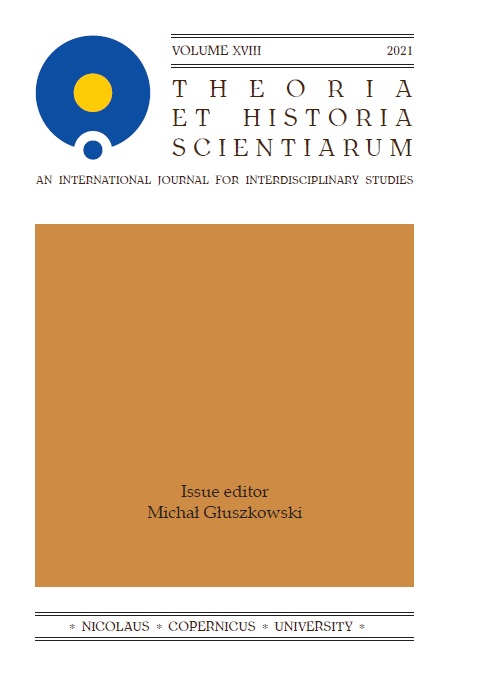Cognitive and semiotic determinants of sign order in gestural and pictorial event representations
DOI:
https://doi.org/10.12775/ths.2021.004Keywords
cognitive semiotics, basic word order, diagrammatic iconicity, gestures, manipulation/construction events, non-verbal event representations, pictures, pantomime, reversibility, semiotic systemsAbstract
The way people order signs in non-verbal event representations of events has been a topic of extensive research in recent decades, with conflicting findings. Based on a literature review, we distinguish the following factors that have been argued to influence sign order: (a) diagrammatic iconicity, (b) manipulation vs. construction events, (c) reversibility, (d) most common word order of L1, (e) the semiotic system (gesture, depiction) used, and (f) a putative “natural” Agent–Patient–Act order. To test the role of these factors, we conducted a study where Swedish participants observed events that varied with respect to reversibility and construction/manipulation status, and then had to communicate them to an addressee using gestures for half the stimuli. For the other half, they used sequences of simple drawings of the event participants and the action. The results showed the huge influence of the semiotic system (e) on sign order. There was a role of reversibility (c) only when gestures were used, while L1 word order (d) only had an effect when sequences of pictures were used. The “ontological status” of the Patient (b) was shown to affect the representations in both semiotic systems but was much stronger for gestures. Even the two most general factors (a) and (f) where shown to be sensitive to the type of semiotic system. Future studies of how such cognitive and semiotic determinants interact are needed to fully understand the phenomenon of sign order preference.
References
Baker, A., van den Bogaerde, B., Pfau, R., & Schermer, T. (2016). The linguistics of sign lan-guages: An introduction. Amsterdam: John Benjamins.
Bates, D., Maechler, M., Bolker, B., & Walker, S. (2015). Fitting linear mixed-effects models using lme4. Journal of Statistical Software, 67(1), 1–48. doi:10.18637/jss.v067. i01.
Christensen, P., Fusaroli, R., & Tylén, K. (2016). Environmental constraints shaping constit-uent order in emerging communication systems: Structural iconicity, interactive alignment and conventionalization. Cognition, 146, 67–80.
Christensen, P., & Tylen, K. (2013). Gestural representation of event structure in dyadic interaction. Tilburg Gesture Research Meeting 2013. http://tiger.uvt.nl/list-of-ac-cepted-papers.html.
Coppola, M., & Newport, E. L. (2005). Grammatical subjects in home sign: Abstract linguistic structure in adult primary gesture systems without linguistic input. Proceedings of the National Academy of Sciences, 102(52), 19249–19253.
Devylder, S. (2018). Diagrammatic iconicity explains assymetries in possessive conctruc-tions: Evidence from Paamese. Cognitive Linguistics, 29(2), 313–348.
Forceville, C. (2011). Pictorial runes in Tintin and the Picaros. Journal of Pragmatics, 43(3), 875–890.
Galantucci B., Kroos, C., & Rhodes, T. (2010). The effects of rapidity of fading on commu-nication systems. Interaction Studies, 11(1), 100–111
Gibson, E., Piantadosi, S. T., Brink, K., Bergen, L., Lim, E., & Saxe, R. (2013). A Noisy-Channel Account of Crosslinguistic Word-Order Variation. Psychological Science, 24(7), 1079–1088. https://doi.org/10.1177/0956797612463705.
Goldin-Meadow, S., Mylander, C. S., Wing C., & Özyürek, A. (2008). The natural order of events: How speakers of different languages represent events nonverbally. PNAS, 105, 9163–9168.
Hall, M. L., Mayberry, R. I., & Ferreira, V. S. (2013). Cognitive constraints on constituent order: Evidence from elicited pantomime. Cognition, 129(1), 1–17.
Hockett, C. F. (1960). The origin of speech, Scientific American, 203, 88–111.
Jakobson, R. (1965). Quest for the essence of language. Diogenes, 13, 21–38.
Kocab, A., Lam, H., & Snedeker, J. (2018). When cars hit trucks and girls hug boys: The effect of animacy on word order in gestural language creation. Cognitive Science, 42, 918–938.
Langus, A., & Nespor, M. (2010). Cognitive systems struggling for word order. Cognitive Psychology, 60, 291–318.
McNeill, D. (2005). Gesture and thought. Chicago: The University of Chicago Press.
Meir, I., Aronoff, M., Börstell, C., Ilkbasaran, D., Kastner I., Lepic R., Lifshitz Ben-Basat, A., Padden C., & Sandler, W. (2017). The effect of being human and the basis of grammatical word order: Insights from novel communication systems and young sign languages. Cognition, 158, 189–207.
Meir, I., Lifshitz, A., Ilkbasaran, D., & Padden, C. (2010). The interaction of animacy and word order in human languages: a study of strategies in a novel communication task. The Evolution of Language: Proceedings of the 8th International Conference, 455–456.
Naidu, V., Zlatev, J., Duggirala, V., Van De Weijer, J., Devylder, S., & Blomberg, J. (2018). Holistic spatial semantics and post-Talmian motion event typology: A case study of Thai and Telugu. Cognitive Semiotics, 11(2), 1–27.
Peirce, C. S. (1958). Collected Papers of Charles Sanders Peirce. Vols. 1–6, C. Hartshorne, & P. Weiss (eds.), Vols. 7–8, A. W. Burks (ed.). Cambridge, MA: Harvard University Press.
Sandler, W. (2012). Dedicated gestures, and the emergence of sign language. Gesture, 12, 265–307.
Schouwstra, M. (2012). Semantic structures, communicative strategies and the emergence of language. LOT publications 312. PhD thesis, Utrecht Institute for Linguistics. OTS.
Schouwstra, M., & de Swart, H. (2014). The semantic origins of word order. Cognition, 131, 431–436.
Stampoulidis, G., Bolognesi, M., & Zlatev, J. (2019). A cognitive semiotic exploration of metaphors in Greek street art. Cognitive Semiotics, 12(1), 1–20.
Vastenius, A., van de Weijer, J., & Zlatev, J. (2016). The influence of native language word order and cognitive biases in pictorial event representations. Cognitive Semiotics, 9(1), 45–77.
Zlatev, J. (2019). Mimesis theory, learning and polysemiotic communication. In: M. Peters (Ed.), Encyclopedia of Educational Philosophy and Theory. Dordrecht: Springer.
Zlatev, J., Blomberg, J., & David, C. (2010). Translocation, language and the categorization of experience. In: V. Evans & P. Chilton (eds.), Space in language and cognition: The state of the art and new directions, 389–418. London: Equinox.
Zlatev, J., Żywiczyński, P., & Wacewicz, S. (2020). Pantomime as the original human-specific communicative system. Journal of Language Evolution, 5(2), 1–19.
Downloads
Published
How to Cite
Issue
Section
License

This work is licensed under a Creative Commons Attribution-NoDerivatives 4.0 International License.
Stats
Number of views and downloads: 572
Number of citations: 0



